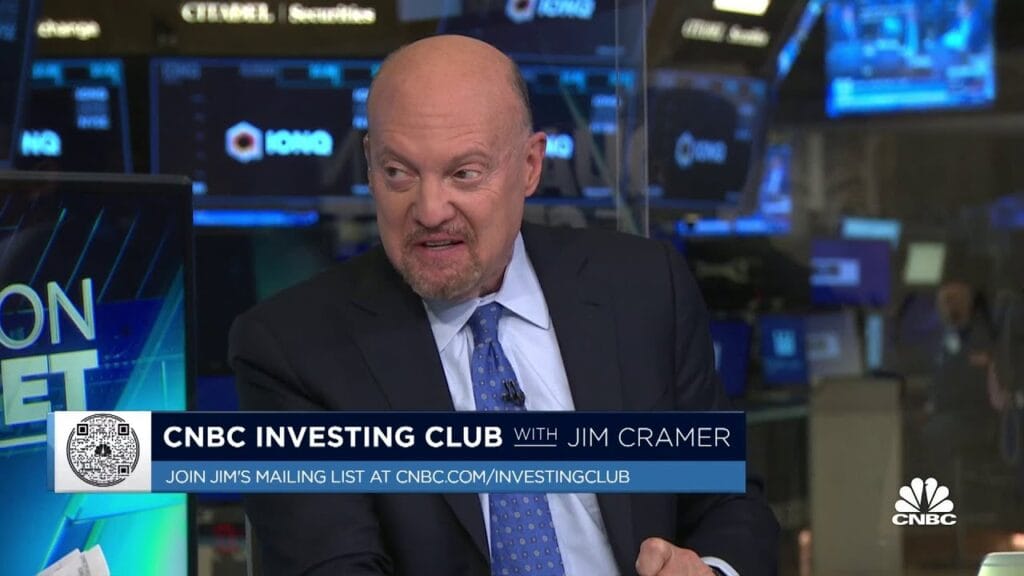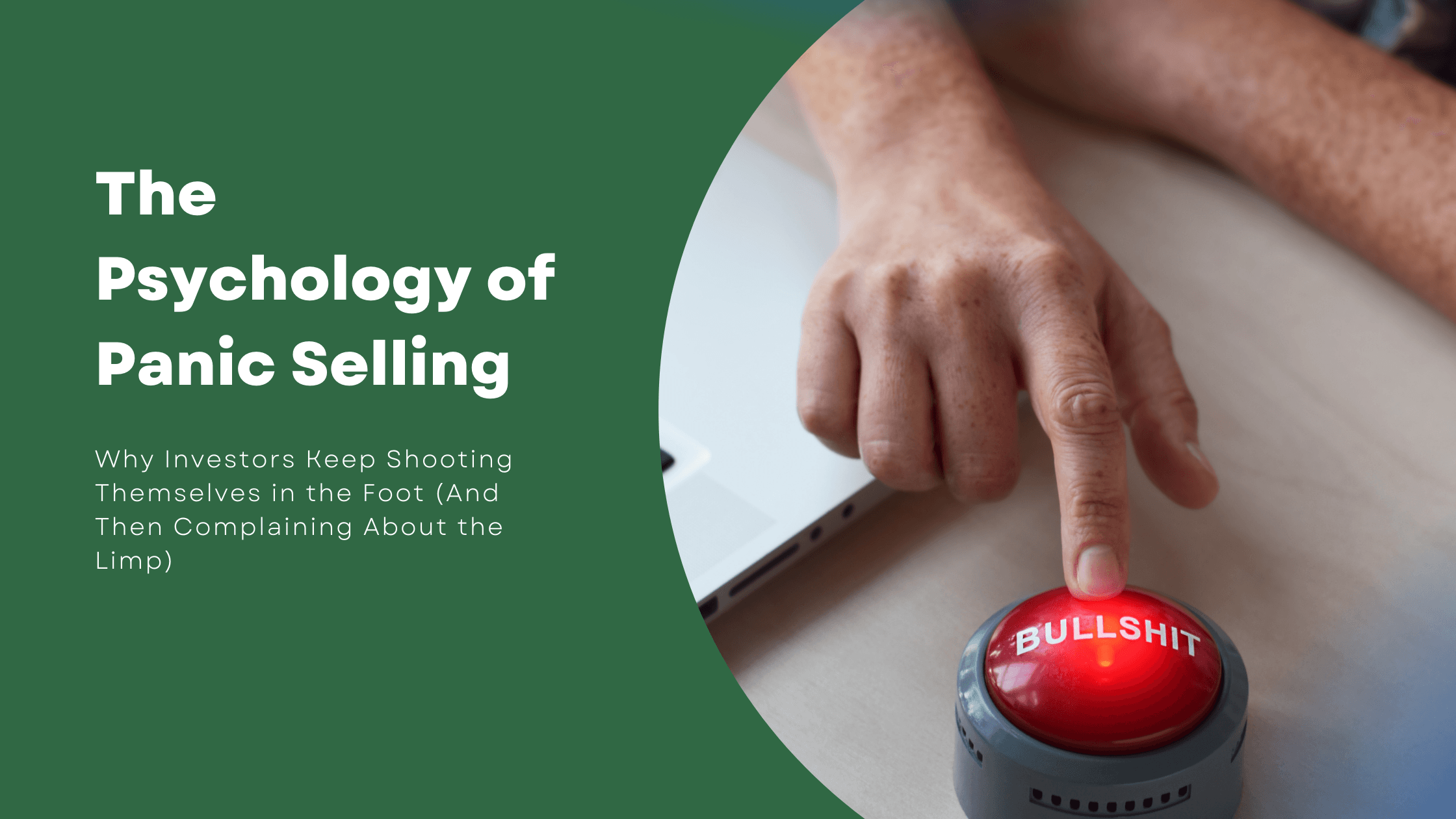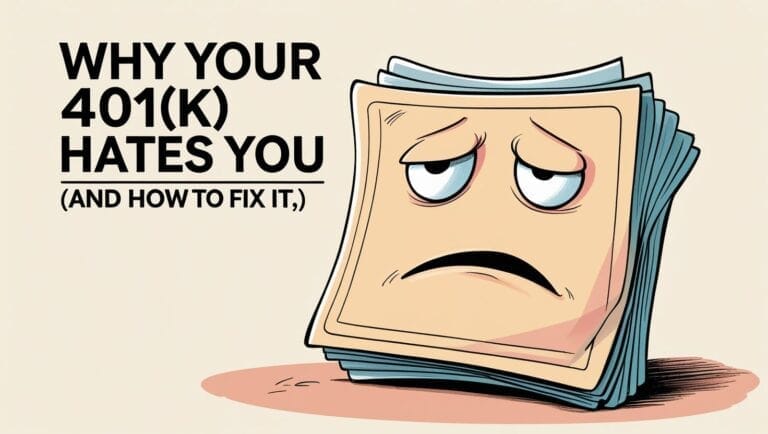The Psychology of Panic Selling: Why Investors Keep Shooting Themselves in the Foot (And Then Complaining About the Limp) in 2025

How To Avoid Panic Selling Without Locking In Permanent Losses
Picture this: It’s just another Tuesday in 2025 when your portfolio suddenly drops 7%. Why? Some central banker tweeted something vague about “economic headwinds” – which basically means they have no clue what’s coming next. CNBC is going full doomsday mode with their red graphics flashing everywhere, and suddenly you’re staring at that sell button like your life depends on it.
So you panic and sell everything, thinking you’re being smart. Fast forward a few months, and the market has bounced back 15%. Now you’re sitting there having locked in your losses, watching everyone else ride the wave back up. Ouch.
If this hits a little too close to home, don’t worry – you’ve got plenty of company. Millions of people blow up their portfolios this exact same way every single year.
But here’s the thing: what if you could stay cool when everything’s going crazy? What if you could actually see those market dips as chances to buy, not reasons to run for the hills?
That’s exactly what this guide is about. We’re going to dive into why your brain tricks you into making terrible financial decisions, and more importantly, how to fight back. By the time we’re done, you’ll know how to keep your head when everyone else is losing theirs.
Trust me, your future self will thank you for this.
What Is Panic Selling and Why Does It Wreck Your Returns?
Panic selling is basically when you freak out and dump all your investments because the market’s having a bad day or some scary headline pops up. It’s like running out of a movie theater because someone sneezed, then missing the awesome ending. You’re turning what could have been temporary losses on paper into real, permanent losses – usually at the absolute worst time possible, while smarter investors are scooping up the bargains you just created.
Why You Really Need to Get Panic Selling right
Look, markets go crazy sometimes. Remember that mess in April 2025 when tariff fears sent everything tumbling? Learning not to panic isn’t just a nice-to-have skill anymore – it’s make-or-break for your financial future.
Here’s a sobering fact: emotional investors have underperformed the market by about 5.5% every single year for the past three decades. That’s not a typo. Without getting this right, your own brain becomes your worst enemy, turning what should be wealth-building into wealth-destroying.
Here’s what you’re protecting when you learn to stay calm:
Your long-term gains: Every single market downturn since 1928 has recovered. Corrections typically bounce back in about four months, bear markets in two years. But only if you don’t panic and lock in your losses at the bottom.
Your sanity: Our brains are wired to feel losses 2.25 times more intensely than gains. Add in social media hysteria and our tendency to obsess over yesterday’s drop (while ignoring the S&P 500’s 10.33% average annual growth since 1957), and you’ve got a recipe for terrible decisions.
Massive opportunities: Remember 2008? The market dropped 57%, but then recovered 400%. COVID in 2020? Down 34% in just 33 days, then up 114%. Panic sellers missed all of that upside.
The bottom line: knowing how to sit tight doesn’t just save you money – it saves your peace of mind too.
How to Actually Stop Panic Selling: 5 Steps That Work
I call this the “Stay Put Protocol.” It’s not about ignoring fear – that’s impossible. It’s about using psychology and some smart automation to make fear work for you instead of against you. Disciplined investors consistently beat emotional ones by 2-3% annually, and here’s how they do it:
1. Make Your Plan When You’re Calm
Write down your investment rules when the market’s boring, not when it’s on fire. Something like: “I only sell if the company’s fundamentals actually fall apart – like revenue dropping 20% year-over-year – or if I genuinely need the money for something important.”
Test your rules against past crashes using tools like Fidelity’s simulators. Data shows rule-based investing beats gut-feeling investing by 2-3% every year. Do this homework now, because when CNBC is screaming about the apocalypse, you’ll be glad you have a plan.
2. Focus on What Actually Matters
Treat stocks like pieces of businesses, not lottery tickets. Look at the real numbers: P/E ratios (historically 15-20 for the S&P), earnings growth (aim for 10%+), dividend yields (1.5-2% is solid).

Ignore the noise. Jim Cramer’s stock picks have lagged the market by 5% – that’s not an opinion, that’s math. When everyone’s panicking, go check the balance sheet. If the company’s still solid, your fear is probably just noise.
3. Think in Decades, Not Days
Trying to time the market is like trying to catch a falling knife – you’re probably going to get hurt. Missing just the best month each year since 1926 would have cut your returns in half.
The S&P has survived 27 recessions, two world wars, crazy inflation, and somehow still delivered 7% real annual gains. Put a 100-year market chart somewhere you can see it. Every scary drop has led to new highs eventually.
4. Keep Some Cash on Hand
Stash 3-6 months of expenses in boring old cash. This stops you from feeling desperate during market drops and having to sell your investments at the worst possible time.
But don’t go overboard – inflation will eat 30% of your cash’s purchasing power over a decade. Keep 5-10% of your portfolio ready for opportunities. When everyone else is selling in panic, you can be buying the sale.
5. Let Robots Do the Heavy Lifting
Set up automatic investments into index funds. Vanguard’s data shows dollar-cost averaging beats trying to time lump sum investments 68% of the time in volatile markets.
Let the computers handle it so your emotions can’t. This “set it and forget it” approach keeps you invested consistently, avoiding those 30-50% trading volume spikes where panicked retail investors dominate the selling.
Extra Tips That Actually Work to stop Panic Selling
Your brain will try to sabotage you – it’s overconfident when things are good (by 30-40% according to Barclays) and terrified when they’re bad. Combat this with a simple 24-hour rule: wait a full day before making any sell decision. Emotions fade, logic kicks in.
Diversify like your life depends on it. Morningstar found that balanced portfolios recover 20% faster from drops. And for the love of all that’s holy, turn off those trading app notifications – studies show they lead to 40% more trades, mostly panic sells.
Next-Level Strategies
Once you’ve got the basics down, consider behavioral coaching or apps that track your trading patterns for biases. Most investors (65%) admit they make emotional mistakes, but only 20% actually seek help.
Try contrarian investing: buy when the fear index (VIX) spikes above 30 – historically, that’s been close to market bottoms. Mental visualization helps too – picture your patient future self wealthy versus your panicked present self broke. Studies show this cuts impulsive decisions by 25%.
If This All Seems Like Too Much Work
Fair enough. You could just buy broad market ETFs like VOO and never touch them – no decisions required, though you’ll miss some active opportunities.
Keeping everything in cash avoids volatility but inflation will slowly eat you alive. Day trading is the opposite extreme, but 80% of day traders lose money long-term due to fees and bad timing.
Robo-advisors like Betterment split the difference – they handle the rebalancing automatically while keeping you invested. Each approach has merit, but for most people, disciplined buy-and-hold still wins.
The Bottom Line: It’s Really This Simple to stop Panic Selling
Avoiding panic selling comes down to understanding that your brain will lie to you, having a plan you stick to, and letting history be your guide. From the 89% crash of 1929 to whatever scary thing happened last week, markets have always recovered.
The track record is clear: the Nasdaq doubled off its 2022 lows, Bitcoin went from $4,000 in 2020 to over $109,000, Amazon climbed from a $6 dot-com joke to north of $220 today. Patience wins, panic loses.
I’ll be honest – I’ve been the idiot before. In 2020, I sold my index funds at the bottom, then bought back higher and torched $5,000 in potential gains. It felt brilliant for about five minutes, then stupid forever. Since then, I’ve learned to ride out the scary parts instead of running for the exits. Guess what? My returns (and my sleep) are way better now.
So here’s your choice: you can be the person who shoots themselves in the foot every time things get scary, or you can be the one who stays calm and lets compound returns do their magic. Your future self will definitely have an opinion about which one you pick.







